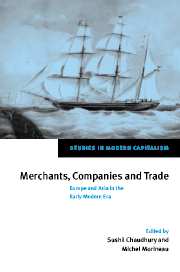Book contents
- Frontmatter
- Contents
- List of contributors
- Preface
- Introduction
- Part I Asia, especially India, around 1500
- Part II Routes, markets and merchants
- Part III European presence in Asia
- Part IV Implications of trade: Asia and Europe
- 13 The Indian challenge: seventeenth and eighteenth centuries
- 14 The changing pattern of British trade in Indian textiles,1701–1757
- 15 French traders and India at the end of the eighteenth century
- 16 The Asian merchants and companies in Bengal's export trade, circa mid-eighteenth century
- Index
16 - The Asian merchants and companies in Bengal's export trade, circa mid-eighteenth century
Published online by Cambridge University Press: 02 December 2009
- Frontmatter
- Contents
- List of contributors
- Preface
- Introduction
- Part I Asia, especially India, around 1500
- Part II Routes, markets and merchants
- Part III European presence in Asia
- Part IV Implications of trade: Asia and Europe
- 13 The Indian challenge: seventeenth and eighteenth centuries
- 14 The changing pattern of British trade in Indian textiles,1701–1757
- 15 French traders and India at the end of the eighteenth century
- 16 The Asian merchants and companies in Bengal's export trade, circa mid-eighteenth century
- Index
Summary
There has long been a surprising consensus among historians that the European East India Companies, especially the English and the Dutch, were the major exporters from Bengal and that they were the principal sources through which silver entered Bengal throughout the first half of the eighteenth century. This implies that the exports of the Asian merchants from Bengal were not at all significant compared with the volume of exports by the Europeans, and hence the Asians had little role in the bullion imports into Bengal during this period. Interestingly enough, the increasing European trade and consequent influx of bullion are said to have had a close connection with the British conquest of Bengal in 1757. It has been argued that, as a result of Indo-European oceanic trade, a ‘Community of interest’ had developed between the Hindu mercantile-banking class of Bengal and the European Companies. Even the latest studies emphasize the role of European trade as the major source of bullion imports and in fostering close relations between the European Companies and the commercial-banking class in Bengal. These authorities even suggest that the interest of the Indian merchants, landholders and warrior class ‘had become far too closely intertwined with the fate of the Europeans’ so that the expulsion of the British from Calcutta ‘could not be borne long’ by the ruling elite and hence the Plassey revolution of 1757 which signalled the British conquest of Bengal.
- Type
- Chapter
- Information
- Merchants, Companies and TradeEurope and Asia in the Early Modern Era, pp. 300 - 320Publisher: Cambridge University PressPrint publication year: 1999
- 1
- Cited by



